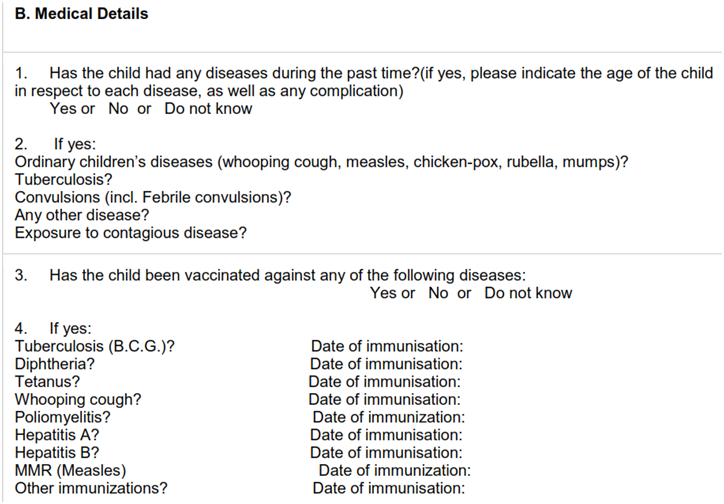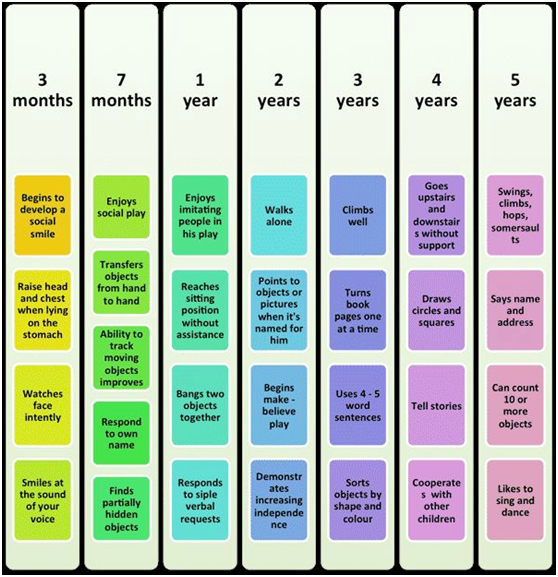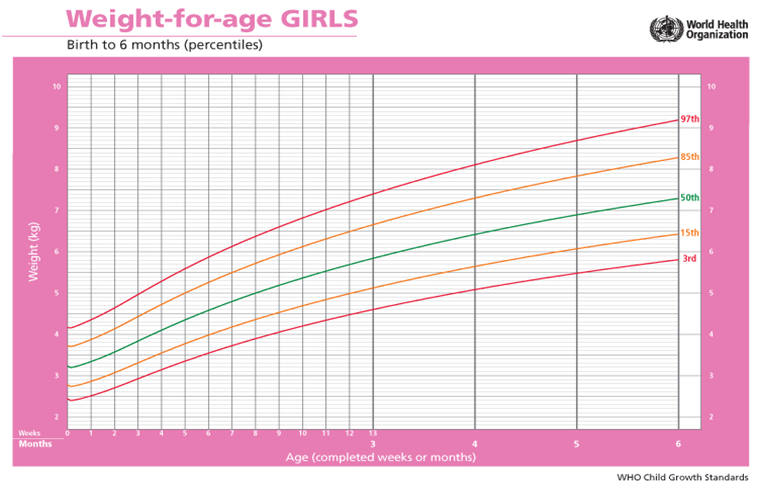1.What does pre-adoptive medical check include?



Head to toe examination

Screening for Ear Tests
There are 2 screening tests that may be used for hearing:
- Automated Auditory Brainstem Response (AABR)—This test measures how the hearing nerve responds to sound. Clicks or tones are played through soft earphones into the baby’s ears
- Otoacoustic Emissions (OAE)—This test measures sound waves produced in the inner ear
What is national immunisation schedule and how many vaccines should my child have got at the time of adoption based on his/her age?
What is catch up immunisation?
A blanket immunisation that is given in case vaccination records are unavailable or the child starts getting immunised late.

Where can I get my child immunised?
At any primary, secondary or tertiary health care centre. Most hospitals and nursing homes with a paediatric facility are equipped with vaccinations under the National Immunisation Schedule.
However, it is always better to go to a known paediatrician who can assess your child and ensure that the vaccination process is simplified and future follow ups are easy.
What information should I check with respect to the medical history of the biological parents?
If medical documentation of the parents is available, then the following is some of the important information to focus:
Birth history of the child:
Whether full term, vaginal or c-section, indication for a c-section (if yes), post -delivery complications (jaundice, respiratory distress ICU, admission)
Obstetric history of the mother
Previous child births, history of babies with congenital anomalies, history of abortions.
Medical history of the parents
- Medical status of the mother (anaemia, thyroid disorder, psychological disorder)
- Any known intake of medications (particularly teratogenic medicines) (Sero-status with regard toHbsAg, HIV)
- History of familial diseases (sickle cell anaemia, haemophilia, thalassemia,etc)
- Blood groups
- History of other medical conditions like tuberculosis, asthma, diabetes, hypertension, seizure disorder
- Any history of breast feeding the child and if yes, then for what duration
What line of action should I take if medical documentation is not available?
If no medical documentation is available then the only way forward is to get a complete and thorough head to toe examination of the child (details above) along with all the required blood investigations.
With respect to immunisation, the catch up immunisation schedule can be followed based on the age of the child. Once this is done, the rest of the immunisation schedule can be followed as per usual guidelines
What are the specific lab tests that should be done after adoption?
Basic screening tests
These are some of the essential investigations that should be done at the time of adoption
- CBC, Peripheral Smear – To rule out anaemia
- Liver Function Test
- Renal function test
- Thyroid Screening
- TORCH – Infection screening for Toxoplasmosis, rubella, CMV, herpes and others
- HbsAg for hepatitis B
- HIV – I & II
- Urine Screening for Inborn errors of metabolism
Additional tests including those that should be performed in high risk areas
- ECG
- ECHO
To rule out congenital heart defects
- USG Abdomen for congenital anomalies of the abdomen like malrotations of the gut, malformed organs, diaphragmatic hernias etc
- X Ray – Chest
Additional tests in high risk areas
- HbS for Sickle cell anemia
- Hb electrophoresis for thalassemia (common type of genetically predisposed anaemia
- Peripheral smear for malarial parasite
Role of paediatrician
What constitutes a complete general physical examination of the baby?
The baby is assessed for the following parameters
- Nutrition
- Hygiene
- Physical Examination – Head to Toe, including plotting of growth charts
- Focus on presence or absence of congenital abnormalities
- Milestones – Attained? Not Attained?
What are the developmental milestones that the child should have achieved for his/her age?
- These are the developmental milestones for an average child
- Certain children may achieve these milestones much faster and some may be slower to attain them.
- It is of more importance to be aware of the RED FLAGS in development

RED FLAGS
Some of the important red flags to watch out for in the attainment of developmental milestones
Upto the age of 3
- Lack of social smile by 2 months
- Absence of stable head control by 4 months
- Inability to recognise mother by 6 months
- Inability to sit when pulled to sit by 6 months
- Lack of independent sitting without support by 8 months
- Lack of creeping or crawling by 9 months
- Inability to stand without support by 1 year
- Lack of pincer grasp by 1 year
- Inability to play interactive games by 1 year
- Inability to walk without support by 18 months
- Absence of bi-syllable word making by 1 year
- Absence of meaningful sentence making by 3 years
How many paediatric visits are desirable post adoption and what are the tests that are essential at each stage?
- How many years follow up?
- 2 years – Social worker once in 6 months
- Pediatrician
- 3 monthly / 6 monthly report
- Monthly report
- By adoptive parents
What is the importance of doing serological tests such as HIV/Hepatitis testing
These are very important tests to be performed especially in a country like India where the prevalence of diseases like hepatitis and HIV infections are very high.
Consider performing these screening tests at the time of adoption if medical documentation regarding the same is unavailable
What role does your paediatrician play in making the adoptive process a smooth one?
- Proper review of physical/motor/verbal/mental examination of the child
- Initiate immunisation and follow up
- Help break social barriers and challenges by actively counselling parents and following up on the child
- The pediatrician should know about the availability of the children for adoption and the procedure for adoption, and the procedures involved in adopting a child.
- Pediatricians have an important role in assisting adoptive families in the various challenges they may face with respect to adoption.
- It is important for pediatricians to be informed about adoption and to share this knowledge with adoptive families.
What are growth charts?
A growth chart is used by pediatricians and other health care providers to follow a child’s growth over time. Growth charts have been constructed by observing the growth of large numbers of normal children over time. The height, weight, and head circumference of a child can be compared to the expected parameters of children of the same age and sex to determine whether the child is growing appropriately. Growth charts can also be used to predict the expected adult height and weight of a child because, in general, children maintain a fairly constant growth curve. When a child deviates from his or her previously established growth curve, investigation into the cause is generally warranted. Example :

So if a child’s weight is at the 50th percentile line, that means that out of 100 normal children her age, 50 will be bigger than she is and 50 smaller. Similarly, if she is in the 75th percentile, that means that she is bigger than 75 children and smaller than only 25, compared with 100 children her age.
Range in India : 3rd to 97th centile. Normal : 50th centile
However some changes to your child’s growth chart may worry your provider more than others:
- When one of your child’s measurements stays below the 10th percentile or above the 90th percentile for their age.
- If the head is growing too slowly or too quickly when measured over time.
- When your child’s measurement does not stay close to one line on the graph. For example, a provider may worry if a 6-month-old was in the 75th percentile, but then moved to the 25th percentile at 9 months, and dropped even lower at 12 months.
Abnormal growth on the growth charts is only a sign of a possible problem. Your doctor will determine whether it is an actual medical problem, or whether your child’s growth just needs to be watched carefully.
Children with special needs
Why should I choose to adopt a child that is differently- abled?
Differently-abled children are generally not the first choice of prospective adoptive parents. But they are the ones most in need of a supportive and loving family to attain their full potential. A child with special needs is the one who can benefit most from the individualized care and resources that adoptive parents can provide rather than an institution. From the parental point of view, all children are a source of happiness, love, meaning and learning; children with special needs are no less in this.
Is the process for adopting a child with special needs different?
- Adoption is easier and faster
- More children are up for adoption
- Special medical care
- Extra care and attention
- Awareness about the medical condition
- Child can be adopted after 15 days when declared legal for adoption
- Decision of CARA is final
What are the common disabilities seen with respect to physical and mental health of the child?
| PHYSICAL | MENTAL |
| EPILEPSY/CONVULSIONS/SEIZURES | AUTISM
MENTAL RETARDATION |
| PARALYSIS | CHILD REQUIRING PSYCHIATRIC TREATMENT |
| MULTIPLE SCLEROSIS | SPEECH IMPAIRMENT |
| NEUROLOGICAL DISORDERS | INTELLECTUAL DISABILITY |
| SEVERE LEARNING DISABILITY |
What is the follow up schedule for children with special needs?
- Acute and chronic medical problems, vision and hearing loss, and developmental delays should be identified and addressed. Important here to stress on the hearing tests that are done as screening procedures in infants
- Behavioral and emotional concerns need to be evaluated aggressively with appropriate therapy initiated.
- Proper medical evaluation, therapy and follow up has to be initiated and maintained as soon as the disability is identified for a better future medical outcome
What should my plan of action be to improve my child’s quality of life/ make a full recovery
- Get educated about your child’s disability. When you first learn of your child’s learning disability, the problem may seem insurmountable. However, when you learn more facts about children with learning disabilities, especially those that grow up to be fully functioning, you can gain the confidence you need to make smart decisions and support your child.
- Many people think that learning disabilities only relate to specific subjects, like math, language, reading, or writing. However, they can affect higher level processes that are less obvious, including time management, organizational skills, focus and concentration, short- and long-term memory, reasoning, etc. Research is vital to understanding the intricacies of their disorder.
- You can also reach out to your child’s therapist, pediatrician, school counselor, and teachers to learn more. Call attention to your concerns by saying “I don’t know much about this disability. Can we schedule a time when you can sit down with me one-on-one and answer some of my questions?”
Participate in support groups to learn from other parents.
As a parent, it’s easy to feel isolated and alone in your journey of parenting a learning-disabled child. When you take part in parent groups, you are able to connect with other parents who understand what it’s like to raise a special needs child. In these groups, you can learn insider information about approaches that help and also learn about additional community resources from other parents.
These groups exist within local communities and online. You can search Facebook for “parents of children with X disability” and usually find numerous groups. Websites specific to each disability also often include discussion boards/chat rooms.
The Parent to Parent Program exists to match parents of children with the same type of disability. In this group, you can participate in a one-on-one relationship with other parents who can share a wealth of information and experience with you.
It may be nerve-racking to speak about your child’s learning disability with a stranger, so be forthright about your uncertainty. Say: “I’ve never done anything like this before, but I want to help my child in any way I can. How does this work?”
Though parents often become pseudo-experts, remember that you are speaking with a non-professional and always consult with your child’s treatment team about anything you want to change or try.
Set realistic goals for progress
Goal-setting is essential to success in all areas of life. It is equally important for children with disabilities. When you set realistic goals, your child has something to strive for, while still accounting for setbacks as well as the limitations of the LD.
Before discussing goals with your child, run them by your child’s therapist or treatment team to ensure they’re realistic. This way you can avoid setting the child up for failure by choosing unreasonable goals.
Sit down with your child and come up with a few short-term and long-term goals that he or she can work towards. Include various action steps under each for how to accomplish the goal. Set a reasonable deadline for achieving it. Come back often and evaluate your progress and modify goals as necessary.
Stick to a routine.
Since your child has to devote an undue amount of focus and concentration on their deficits at school and at home, you can help them function in other ways by making sure they follow a regular schedule. Doing so can help your child learn in a natural and structured way while reducing confusion and overwhelming.
A routine helps your child set realistic goals, adopt consistent behaviors, and improve in difficult tasks and subjects. For instance, waking and rising at the same time each day and completing chores/tasks in a set order can help your child feel more secure. When things are constantly changing, it can be hard for a learning-disabled child to catch on, causing a dive in his/her self-confidence.
Avoid falling into self-pity
Practice empathy instead. Pitying yourself or your child can be a detrimental to positive change and progress. Feeling like a victim prevents you from taking the necessary steps to improve you and your child’s situations. Overcome the need for self-pity in you and your child
- Practicing empathy and compassion for yourself without viewing yourself as a victim
- Looking to your strengths in difficult times
- Recognizing every small victory or mark of progress
- Looking around you at the struggles of others to help provide perspective
- Reading inspirational stories of people who have overcome obstacles and thrived
- Volunteering your time or resources to others
Stay involved at your child’s school
When your child is diagnosed with a learning disability, he or she is in dire need of an advocate to ensure that they are treated fairly and receive the same education as all other children. You are your child’s advocate, which is why being informed about your child’s LD is so important.
Work with your child’s school system to determine appropriate objectives for your child, modify his or her Individualized Education Plan (IEP), and share new research of effective approaches.
Communicating with your child’s school may be stressful, but remember to maintain a goal-oriented focus and be persistent in getting your child’s needs met.
